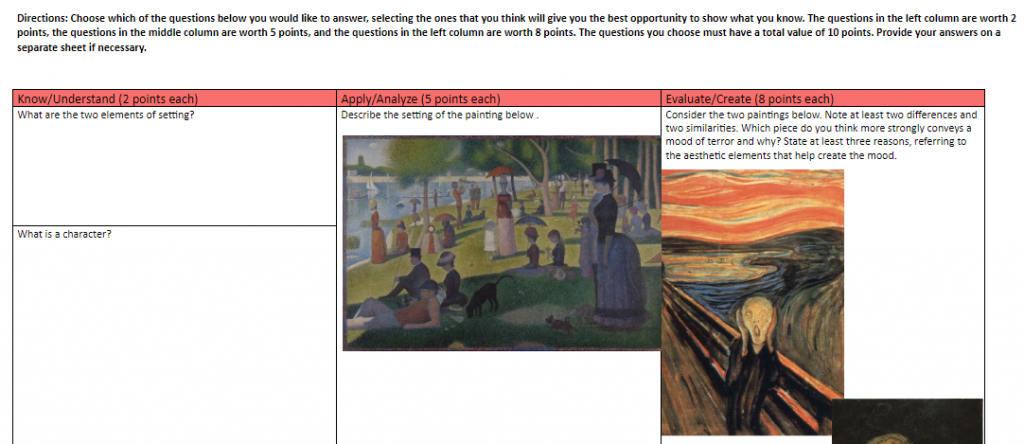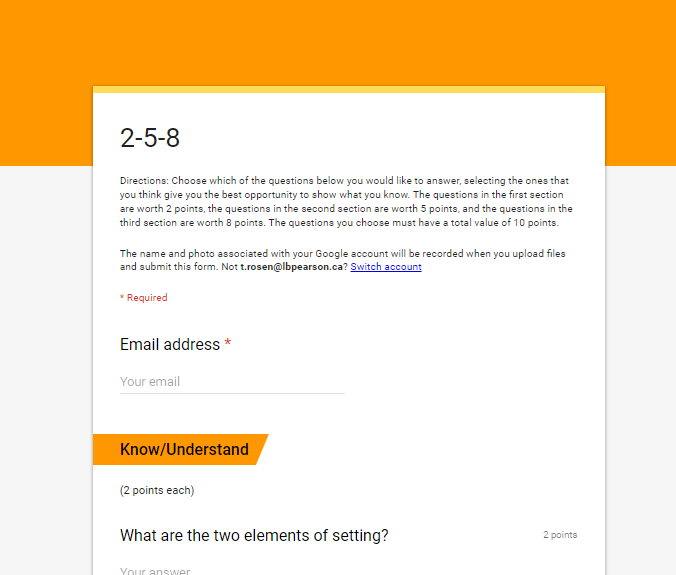Questions for reflection:
What does flexibility in assessment look like?
What are practical ways to differentiate our assessment practices and accommodate all students?
note: An assessment package for Eng 1102-2 is included in this article, along with suggestions for how to modify it for other subject areas.
Why Differentiate Assessment?
As teachers, we often find ourselves needing to differentiate instruction to meet the needs of the wide range of learners we have in our classes. If flexibility in teaching is necessary to accommodate all students, then flexibility is needed in the way we assess our students as well. Differentiation is one way to be flexible in our assessment practices.
Although we usually begin each lesson with a learning objective that we intend to help each student reach, we know that not all students will have the same level of readiness when it is time to assess. Some students may not reach the objective as quickly as others or in the same way. It is still necessary to assess their learning and help guide them as they progress towards the learning goal and develop their competencies within the subject matters we teach. We can differentiate assessment to check in with and provide feedback to all of learners.
How do we get started with differentiating assessment?
To differentiate assessment, we start with our learning objective, and consider what success might look like for students who have higher or lower levels of readiness. Referring to Bloom’s taxonomy can help in choosing appropriate goals and assessments for our range of students.
For example, consider a learning situation in Enjoyment and Entertainment I (ENG-1102-2) where the student is put into the role of assistant to a museum curator and must describe pieces of art by remarking on the setting, mood, and characters in the paintings. These elements are part of the essential knowledge of the course and it would be important for teachers to assess students’ understanding of these concepts before continuing with the learning tasks.
The learning objective at this point in the situation is that students can apply their knowledge of setting, mood and character to art pieces, and they can analyze the artwork to be able to comment on these elements in the piece. However, there may be students who are still struggling to understand the concepts of setting, mood and character or to apply their knowledge of these elements, and there may also be students who have an advanced understanding of these concepts.
For those who are struggling, rather than giving them an assessment that expects them to apply and analyze (level 3 and 4 of Bloom’s taxonomy), we can assess their knowledge and understanding (level 1 and 2 of Bloom’s taxonomy). We can make sure that their knowledge and understanding of the concepts is adequate before we help them to proceed to the next stage.
For our advanced students, we can push them a step further and rather than asking them to only apply and analyze, we can have them evaluate and create (level 5 and 6 of Bloom’s taxonomy) as well.
Rather than giving students more or less work depending on their readiness, we want to give them qualitatively different tasks that allow them to show what they know and can do.
The 2-5-8 Assessment Plan
A specific tool that can be useful in differentiating assessment according to Bloom’s Taxonomy is the 2-5-8 assessment plan. It can be used with a wide range of students, and allows them choice in selecting the tasks that best correspond to their readiness (see below for a note on this). The questions on this kind of assessment have different weights depending on their level on Bloom’s taxonomy:
- know/understand questions are 2 points
- apply/analyze questions are worth 5 points, and
- evaluate/create questions are worth 8 points.
Students can choose which questions they answer, as long as the weighting of the questions they choose totals 10 points. Teachers reserve the right to veto students’ choices when necessary and prompt them to answer appropriate questions, such as in the case of an advanced student who wants to solely answer know/understand (2 point) questions.
Note about readiness – as teachers, we also need to be careful about guiding our students too much to respond to only questions related to knowledge and understanding. There is some discussion about how this can create a social divide in learning. As well, there is the argument that we learn by doing, so that the application and creation kinds of activities are important in order to develop and strengthen knowledge and understanding. For more on this, read We Learn by Doing: What Educators Get Wrong About Bloom’s Taxonomy by Ron Berger.
When and How to Use 2-5-8
This assessment is for students to complete independently and can be done digitally or as a pencil-and-paper task, so whether it is used in a traditional teacher-led classroom, an individualized learning setting, a small group or stations class structure, an online course or blended learning environment, the 2-5-8 assessment is a versatile tool. The format (physical or digital) and content is fully customizable. Include as many or as few questions as you’d like, and you can adjust the total points value of the 2-5-8 as well.
An example of a 2-5-8 Assessment
In the case of the learning situation mentioned earlier, in which students are being assessed on their understanding of aesthetic elements, a 2-5-8 assessment might look like this:
Word document version of 2-5-8 assessment of aesthetic elements.
Or like this:
Or like this:
Google form version of the 2-5-8 assessment of aesthetic elements
Extending 2-5-8 Assessments to other Subject Areas
The 2-5-8 assessment can be used in a variety of learning contexts. To check students’ understanding of a grammar concept in English or French, content in a biology or science module, or when learning geometry or algebra, the 2-5-8 is a way to differentiate assessment and guide all students to success.
Here are some sample questions from different subject matters:
2 point know/understand questions:
- Label the diagram of the digestive system.
- List the events in the story.
- When did Cartier make his first trip to Canada?
- How many milliliters are in a liter?
- Explain the process of photosynthesis.
5 point apply/analyze questions:
- Compare the protagonist’s feelings at the beginning of the story to their feelings at the end of the story.
- The recipe below yields 4 servings. How much of each ingredient would you need if you wanted to feed 10 people?
- What are some of the factors that caused the Quiet Revolution?
- Using the simple future tense, write a paragraph about your weekend plans.
- Classify the following as animal, vegetable or mineral.
8 point create/evaluate questions:
- How might life be different if Canada didn’t confederate in 1867?
- Which gazebo design plan is most feasible and why?
- Was it realistic that the character reacted the way he did? Why or why not?
- Create a daily menu plan for an adolescent female that respects the Canada food guide recommendations.
- Write a monologue that expresses the feelings of the main character at the end of the story.
Do you want to create your own 2-5-8 assessment tools?
You can create your own by using these links.
Make a copy of the Google Form version
Make a copy of the Google Slides version
Make a copy of the 2-5-8 Evaluation Guide
Assessment should be as flexible as our instruction is, and the 2-5-8 is one tool that can help us achieve that goal.
 Lashiah De Clou has been an adult educator since 2009 and has a passion for teaching literacy. Having recently obtained a Master’s degree in Educational Psychology, she is enthusiastic about developing as a teacher and sharing her learning with others.
Lashiah De Clou has been an adult educator since 2009 and has a passion for teaching literacy. Having recently obtained a Master’s degree in Educational Psychology, she is enthusiastic about developing as a teacher and sharing her learning with others.


